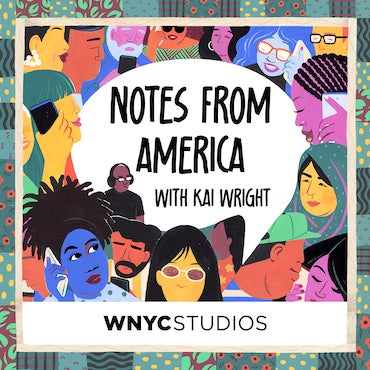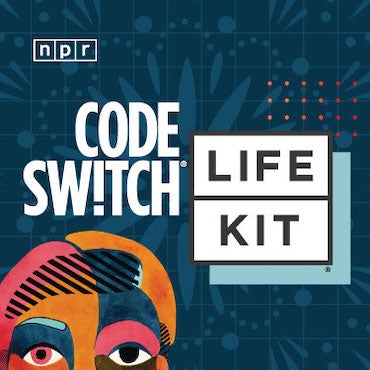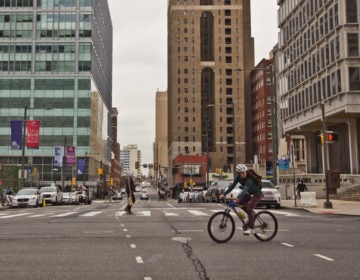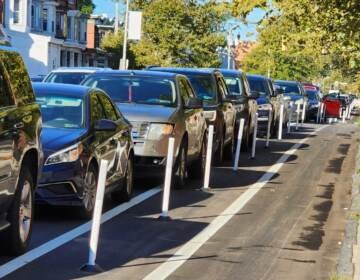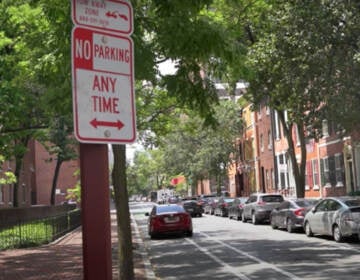Philly vows to slow rising traffic fatality rate with more speed enforcement — and bikes
Announced as traffic fatality rates soar to historic levels, Philadelphia’s latest Vision Zero plan hinges on changing drivers’ behavior.
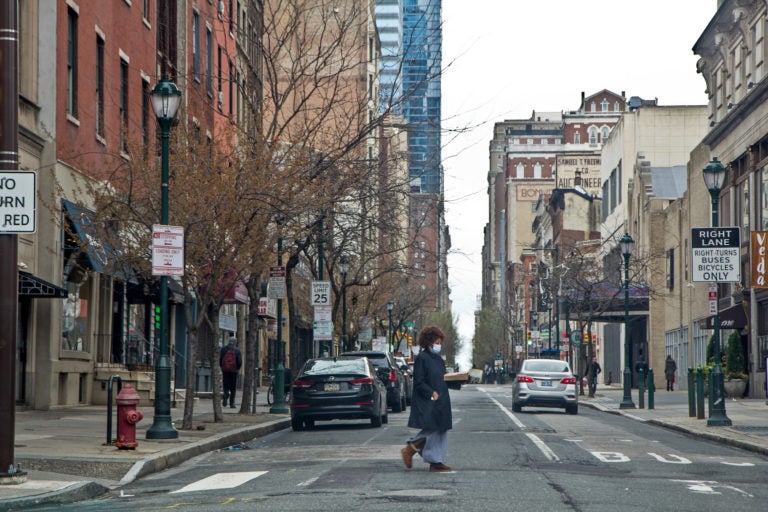
Center City Philadelphia. (Kimberly Paynter/WHYY)
On the heels of the worst month for traffic deaths in four years, Philadelphia officials rolled out a plan to reduce traffic deaths in the next five years — and ideally down to zero by the year 2030.
The 2025 Vision Zero action plan hinges on changing the behavior of drivers. The plan says it’ll reduce speed on Philly’s roads by installing infrastructure that encourages motorists to move more slowly.
Philadelphia Police have said that drivers killed 25% more people this year than last, including people on foot, bike, or other drivers. July saw the worst of it, with 24 Philadelphians losing their lives in traffic crashes
Now, the city has one of the highest auto-fatality rates in the nation — soaring above New York, Boston, Chicago, and San Francisco, according to Vision Zero data.
City officials say they’re approaching the next five years with urgency.
“2020 has been a difficult year for Vision Zero,” said Mike Carroll, director of the Office of Transportation, Infrastructure, and Sustainability. “Although we know we cannot look to anyone year in isolation, our trend toward zero needs to shift down in order to reach our goal of zero by 2030.”
Carroll and other city officials released the Vision Zero remake one day after a driver allegedly hit a 69-year-old Logan resident and sped away. After a passerby called 911 to report the hit-and-run at 16th Street and Belfield Avenue, medics took the crash victim, Patricia Williams, a pedestrian, to Albert Einstein Medical Center. There, a CAT scan detected bleeding in her brain. Williams was the fifth fatal hit-and-run victim in seven days.
University of Pennsylvania city planning professor Erick Guerra, who studies regional crash data, has attributed the spike in crash deaths to increased alcohol consumption and emptier streets more conducive to speeding — both side effects of the coronavirus pandemic.
“People are drinking more during COVID so probably a high share are drunk. And people know there’s a higher consequence, so they run,” Guerra said. “The other reason is just speed…When there are less people on the road, you can go faster. And that really impacts the fatality rate.”
The new Vision Zero plan seeks to focus on three main strategies:
- More Neighborhood Slow Zones
- Expanded automated speed enforcement
- Hundreds of new Indego bike share stations
What they got right, and what’s coming next
Despite the grim reality that we’ve seen on Philly streets this year, the Vision Zero plan first touted a few accomplishments. Speed cameras were installed as part of a pilot program on Roosevelt Boulevard, along with 10 miles of protected bike lanes in neighborhoods like Center City and South Philly.
A 1.1-mile stretch of Chestnut Street was outfitted with protected bike lanes, and in just two years, traffic injuries on the street fell by 80%. After receiving similar treatment, Market Street saw a 13% reduction in speeding.
Though successful by some measure, these efforts didn’t seem to make a meaningful dent in traffic deaths citywide.
Among the victims of dangerous traffic patterns in 2020 was Avante Reynolds, a 25-year-old West Philadelphia mother killed in a hit-and-run on the consistently dangerous Cobbs Creek Parkway. That roadway has been allocated more than $6 million in funding for traffic safety changes from the PennDOT Highway Safety Improvement Program and $1.5 million from the 2018 Automated Red Light Enforcement fund.
The plan never specifically addresses hit-and-run incidents — rather the reduction of speeding as a whole.
An updated High Injury Network
We’ve got an updated High Injury Network for the first time since 2016.
Previously, Vision Zero’s High Injury Network used crash data collected from 2012 to 2016 to isolate the 12% of Philadelphia streets responsible for half the city’s traffic deaths and severe injuries.
With the new action plan, the HIN got a much-needed refresh. Now, it uses data from 2014 to 2018, and it found Philly’s known dangerous roads contribute to a more major chunk of crashes than we thought: 12% of the city’s roads were home to 80% of traffic deaths and injuries.
More Neighborhood Slow Zones
We’re still waiting on Philadelphia’s first two Neighborhood Slow Zones, hyperlocal areas that try to encourage safer driving with extra traffic-calming devices and lower speed limits.
In early 2019, Philly officials selected two spots for Slow Zones: the area around Willard Elementary School in Kensington, and a section of Fairhill between North Second and Fifth streets and Allegheny and Glenwood avenues. They’ll finally be unveiled in Spring 2021.
A new update: We’ve got at least three more Slow Zones in the pipeline
Carroll said OTIS officials are actively working with the community to design a third Slow Zone around Cramp Elementary in Fairhill — and they’re in the early stages of outreach for another one in the West Passyunk neighborhood and around the Tenth Memorial Baptist Church in Sharswood.
Another round of applications for even more Slow Zones will open in the spring of next year. Each one costs $500k, funded through red light camera enforcement tickets.
Tentative plans for other streets
Thanks to that new High Injury Network, Vision Zero officials could prioritize some corridors that are the most in need of change. Some of them include:
- Allegheny from 2nd to 5th
- Broad from Lehigh to Allegheny
- Cobbs Creek from Market to Spruce
- The intersection of Hunting Park and Roosevelt Boulevard
- Frankford from Arrott to Bridge
Improvements on all the intersections or roadways are unlikely by 2025, per the action plan. It’s more like a “pathway” for future improvements down the line.
Automated speed enforcement and more bike lanes, if the state will allow it
The plan also begs for some legislative change at the state level. Vision Zero officials outlined a small handful of changes they’d like to implement — but first, the PA House and Senate would have to pass policies to greenlight those updates.
There’s Senate Bill 565 and House Bill 792, for example, which would update the technical definition of a “curb” to make it easier to set up more protected bike lanes. They’d also like local control of speed limits, which are currently set at the 85th percentile of a road’s regular speed.
Another lofty goal, if the state will allow it: the VZ team wants to secure the speed cameras on Roosevelt Boulevard — currently, they’re just a five-year pilot program — and install more of them on High Injury Network corridors. Carroll called it a safer alternative to enforcement by police officers.
“There’s a lot of issues in the public now around policing in general, and police have a lot of work to do,” Carroll said. “One of the beautiful things about automated speed enforcement is it’s bias-free.”
But that would take approval from the state and PennDOT, and the plan didn’t outline a specific path to achieving that.
More SEPTA use and Indego stations
Citing American Public Transportation Association data that show riding transit is 10 times safer than driving, Vision Zero officials say they want to move more people from their cars to SEPTA.
A few of their goals:
- Improve bus travel times by 5%
- Install special stoplights for trolleys
- Beef up transit options so that 10% of Philly residents are within a quarter-mile of frequent public transit by 2025
There’s also attention being paid to Philly’s bike-share program. With 140 Indego stations currently open in Philly, Mayor Jim Kenney said the program will jump to 350 docks by 2025.

Subscribe to PlanPhilly
WHYY is your source for fact-based, in-depth journalism and information. As a nonprofit organization, we rely on financial support from readers like you. Please give today.
